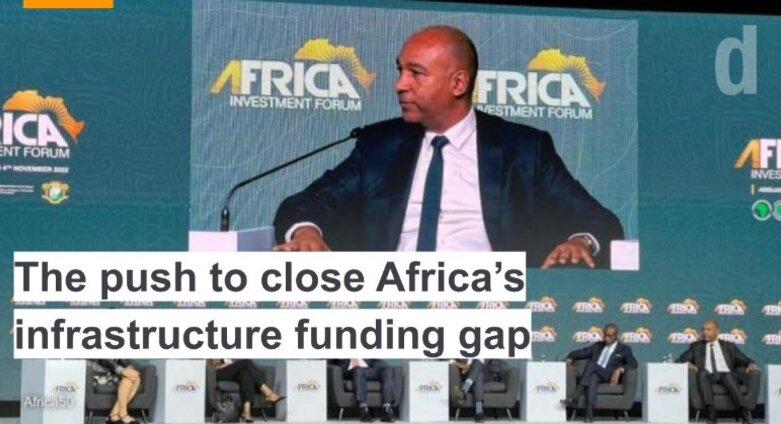Vincent Le Guennou: The push to close Africa’s infrastructure funding gap
 Vincent Le Guennou speaking on a panel at the Africa Investment Forum 2022 in Abidjan.
Vincent Le Guennou speaking on a panel at the Africa Investment Forum 2022 in Abidjan.Significant investments are required to meet Africa’s infrastructure funding gap. Vincent Le Guennou, CEO of Africa50’s new Infrastructure Acceleration Fund, explains how the fund seeks to inspire a multiplier effect on financing across the continent.
When it comes to infrastructure in Africa, bridging the financing gap is a major challenge. The African Development Bank estimates between $130 billion and $170 billion is required for infrastructure development each year, leaving a gap of around $100 billion.
Multiple efforts are taking place to make up this shortfall, but the failure rate of projects is high. Innovative funding methods are therefore called for to meet these crucial infrastructure needs — with, for example, nearly 600 million people in sub-Saharan Africa lacking access to grid electricity.
To help unlock such financing, Pan-African infrastructure investment platform Africa50 launched its Infrastructure Acceleration Fund, or IAF, in 2021. The 12-year private equity fund aims to attract investors to drive transformative impact, create jobs, and accelerate Africa’s green industrial revolution.
Seeking to ultimately raise $500 million in commitments, Africa50 IAF reached its first close this December 2023 after securing $222.5 million and will now start deploying capital. It has gained 16 African institutional investors, including the African Development Bank, plus the International Finance Corporation.
The hope is that the fund will set a precedent, creating a multiplier effect. “Making sure this fund is a success would help more capital to be allocated to infrastructure in Africa,” said Vincent Le Guennou, CEO of the Africa50 IAF. Speaking to Devex, he explained why the new fund is needed and how it will help improve financial flows for infrastructure projects in Africa.
This conversation has been edited for length and clarity.
What are the main needs when it comes to mobilizing funding for infrastructure projects across Africa?
The African Development Bank is telling us that bridging the funding gap would require the mobilization of around $100 billion per annum. Meanwhile, the failure rate for developing infrastructure projects is huge, with management consulting firm McKinsey & Company estimating that only 10% reach financial close. When you have those two elements in mind, you have the beginning of the answer to the question.
What part does Africa50 IAF play in meeting these needs?
We have four key target sectors for investment: power and energy; water and sanitation; transportation and logistics; and digital and social infrastructure. We can be an active minority shareholder, or we can take a majority shareholding. The plan is to have a balanced portfolio between majority and minority investments.
We will invest in mature projects and companies rather than doing project development right from the start, which is more a focus of Africa50 - Project Development, one of Africa50’s three strategic pillars. By doing that, we also avoid that risk at the early stage.
An example might be a renewable energy project in East Africa, where sponsors come to us after the feasibility studies have been done and the concession contracts signed, and then want us to come in when they’re finalizing the equity round. Or there might be a telecommunications tower company that’s a proven business, but that’s growing and needs more capital.
What’s the significance of the first close of funding in the Africa50 IAF, securing $222.5 million in commitments?
At $222.5 million raised of the ultimate target of $500 million since the fund’s creation two years ago, we’ve now reached critical mass. We have participation from 16 African investors, including sovereign wealth, pension and social security funds, insurance companies, banks, and development finance institutions. After declaring the first close, we can start deploying capital in projects and have 12 months to reach the final target.
We want to be diversified across the continent and when we reach the $500 million target, the intention is to have 10 to 12 investments each with a target size of $40 million and above. To help further diversify this reach, we also value working with companies with operations in multiple countries.
What’s Africa50 IAF’s mission?
We have what we call a double bottom line: First, projects have to deliver commercial returns for investors. Second, they have to achieve social and economic development, contributing to some of the U.N. Sustainable Development Goals.
Our long-term objective is also to demonstrate that investing in infrastructure in Africa can deliver commensurate returns so that institutional investors on the continent become increasingly comfortable with infrastructure as an asset class and invest more money in it. In this way, we would expect some sort of multiplier effect over time.
According to the African Development Bank, there are an estimated $2.5 trillion of assets under management by pension funds, insurance companies, sovereign wealth funds, and other institutional investors on the continent. The question is: How do you induce those entities to allocate more of their resources to financing infrastructure in Africa? One way is to demonstrate that it’s doable and that you have a track record of delivering commercially attractive returns.
What are the benefits of securing mainly African investors so far?
Of the 17 investors that have committed to the first close of the fund, 16 are African institutional investors — which is unique in my experience. For one thing, we believe it’s going to be easier to also attract non-African institutional investors now as they can see that African investors themselves believe strongly in the continent and infrastructure there.
Category: Press Release
